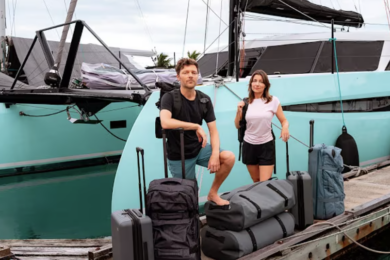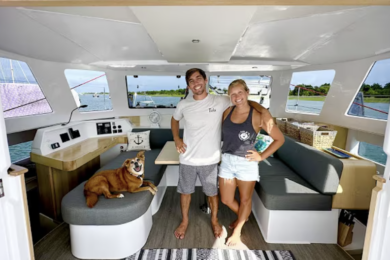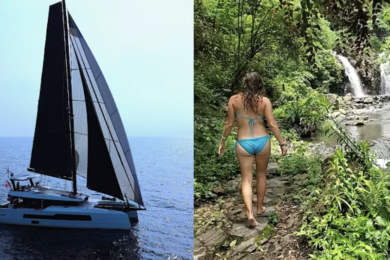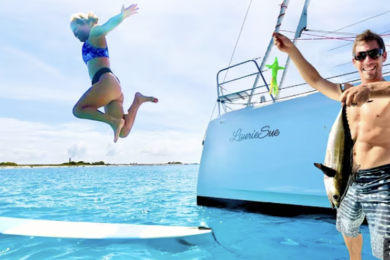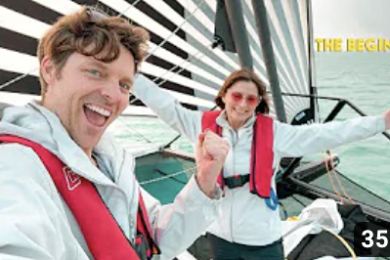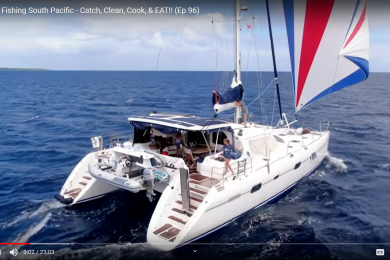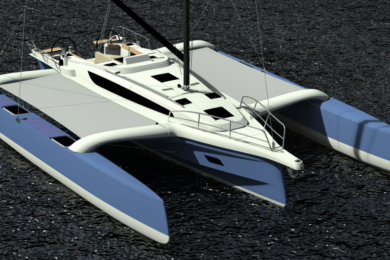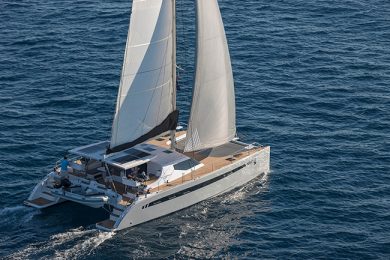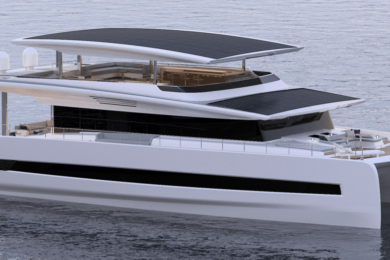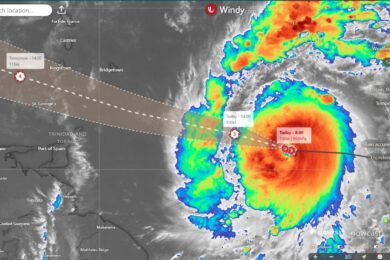A veteran sailor, dealer and broker discusses the pros and cons of the two types of cruising boats (Published 2009)
attended with disadvantages.” For Hume the good life had nothing to do with the quest for perfection, but the effort to discover the wise compromise that might inch us closer to fulfillment. Every person who contacts The Multihull Company is striving to follow Hume’s advice (whether they know it or not!). They hope to make the wise compromise when choosing their yacht. As such, they seek honest answers to three primary questions:
Is a sailing catamaran really right for them?
If so, what is the best catamaran for their needs and budget?
And which catamaran offers them the most value for their dollar?
Here I’ll endeavor to tackle the first question by discussing the advantages and disadvantages of a catamaran over a monohull.
COMFORT AT ANCHOR
The great success of catamarans in charter programs over the past decade is due primarily to the fact that catamarans offer enormous advantages over monohulls when the anchor is dropped. These benefits are as follows:
Catamarans are considerably more stable than a monohull. As such, they do not bang back and forth in swells. So catamaran cruisers can eat, sleep and live far more comfortably on the hook than a monohuller.
Catamarans are much wider than monohulls and therefore provide enormous aft cockpits. In tropical climates this is an huge plus.
The main saloon of a catamaran is on the same (or nearly the same) level as the cockpit. Unlike a monohuller, catamaran sailors do not step down into a deep dark place (where the windows are generally above eye level), but rather straight from the cockpit into a light-filled saloon. I don’t mean to get New Age here, but catamaran sailors truly “Live in the Light.” Onboard a catamaran you remain intimately connected to the world outside. This makes cooking, reading, dining, navigating and lounging far more pleasant on a catamaran than a monohull.
Because catamarans are more stable, those onboard do not enter into an extended stowing routine whenever they hoist anchor. Similarly, catamaran sailors do not enter into an extended un-stowing routine when they drop anchor. Having lived on both catamarans and monohulls, I cannot stress what a huge plus this is for liveaboard sailors.
When sailing with three or more people catamarans offer much more privacy as the two hulls, and the suites and heads within them, are far away from each other.
SPEED UNDER SAIL
Because a catamaran does not have to carry a heavy lead keel underneath to stay upright, they are generally faster than a similarly sized monohull—especially off the wind. However, catamarans that carry keels cannot point as high into the wind as a monohull. They will, however, typically arrive at an upwind destination at about the same time because they are moving much faster. They sail a greater distance, but at a much higher speed.
A catamaran with daggerboards and good quality sails will point as high as a similar sized monohull. It will also travel at a much higher rate of speed and therefore arrive at upwind destinations sooner. (Note: these are generalizations based on apples to apples comparisons—a performance monohull vs. a performance cat, a cruising cat vs. a cruising monohull, etc.) It is important to note that most of the production catamarans on the market are underpowered charter designs made for trade wind sailing. In light airs many of these designs perform poorly unless larger headsails or a mainsail with more roach are added.

In winds under 8 knots most catamarans, due to extreme wetted surface drag, are not any faster—and often slower—than similar sized monohulls.
COMFORT UNDERWAY
Because a catamaran does not heel it offers far more comfort underway than a monohull.
For example cooking is much easier on a cat underway and more pleasant as you are looking out on the world and not “down below.” Most catamarans do not have gimbaled stoves and ovens because they simply don’t need them.
Your guests are far less prone to seasickness because you have mostly fore and aft pitching and very little beam-to-beam motion. Catamarans don’t roll from swell to swell like a monohull.
Walking on the deck of a cat underway is far easier as the boat is sailing flat. This makes sail changes and reefing much, much easier and a lot safer. The danger of falling overboard on a catamaran is considerably less than on a monohull.
Finally, it is much nicer to sleep on a boat that doesn’t heel.
One advantage most monohulls do have when underway is that they don’t pound or slap. Catamarans with low bridge deck clearance (the distance from the water to the bottom of her saloon floor underneath the boat) are prone to pounding and slapping on the undercarriage in lumpy confused seas when sailing upwind. This banging and slapping is quite disconcerting when you first experience it. At times, in very lumpy seas, you will feel as though the boat is getting pounded to pieces. Most monohulls just don’t pound in this manner and are therefore a bit more comfortable than low bridge deck catamarans when beating into severe lumpy seas in high winds. Note that I am talking about lumpy seas, not necessarily large ones. In large swells bridge deck slapping is generally not a problem. The problem comes in cross-swells and confused seas—what I like to term, “Washing Machine seas.”

To overcome the unpleasantness of pounding I believe strongly in catamarans with excellent bridge deck clearance and semi-rounded under carriages that disperse wave action. I also prefer catamarans with few hull protrusions or chines as they increase not only slapping and pounding but magnify hydrodynamic drag.
SAFETY
Monohull sailors have for years argued that multihulls are not nearly as safe. I heartily disagree. One of the primary laws of physics is that “Everything in nature seeks its most stable position.” The most stable position for a catamaran is indeed upside down on the top of the ocean. But the most stable position for a monohull is at the bottom of the ocean. A well-built and properly designed catamaran is very hard to sink—you must either be run over by a tanker or suffer a massive fire.
Multihulls gained a bad reputation in the 60s and 70s because most of them were home built, not beamy enough and poorly designed. But modern multihulls are very hard to capsize. It really takes a monumental act of bone-headedness to capsize a modern cruising multihull in winds under 70 knots. If you are so bold as to cruise around far offshore in hurricane zones, well, yes, you are taking a serious risk. But so is a monohull sailor. Fact is, monohulls sink about as often as catamarans capsize, which explains why Lloyd’s insurance policies on cruising boats are nearly the same for cats and monohulls of similar value. (Note: racing multihulls capsize quite often because they are little more than Hobie Cats on steroids, driven to the edge at all times by thrill seeking racers.)
In short, monohull sailors are rescued from life rafts. Multihull sailors are rescued from capsizes. Where would you rather be? Sitting in a small life raft in a storm or sitting securely inside your much larger and more stable upside down multihull? For me, the answer to this is a no brainer.
A faster boat is also a safer boat, as the faster boat is exposed to fewer storms. A catamaran that can regularly pull 220-mile days on a passage from Panama to Hawaii will be exposed to far less storm risk than the monohull that has a hard time regularly pulling 175-mile days. With good weather routing information a multihull can avoid most serious weather and, at worst, place itself in the most favorable position to avoid the brunt of a storm. Since most multihulls can run before a storm between 10 and 15 knots they offer considerably more options and therefore safety than a boat that has difficulty topping out over 9 knots.

I would say that a monohull is preferable for serious offshore single-handed sailing because you can heave-to in a howler and sleep it out more easily than you can on a catamaran. A multihull does require very careful seamanship in serious storms. For this reason I believe monohulls are better suited to single handed sailing or voyaging in high northern and southern latitudes. A super well-built monohull may capsize or even roll in a storm, but they generally pop back up, even if the rig has been swept away. Once a catamaran goes over she stays over. But, here again, she generally stays afloat, offering an excellent place to survive until one is rescued.
I also believe that catamarans are superior to monohulls in terms of redundancy, since cruising catamarans generally carry two diesel engines An engine failure on a monohull is the end of motoring. Not so on a catamaran. In fact, when motoring, most catamaran sailors only use one engine to conserve on fuel. They use two engines to dock.
And a catamaran has two hulls, not one. Should one of the hulls be damaged you still have another one for buoyancy. A hull fracture on a monohull is a far more serious and dangerous thing than it is on a multihull.
MANEUVERABILITY
Because most catamarans have twin engines they are far easier to dock than a single engine monohull. A modern catamaran can do a 360-degree turn in her own length. A monohull cannot do this. However, a monohull under sail is much more maneuverable and certainly will tack a lot faster than a catamaran.
In shallow areas the catamaran is clearly superior to a monohull. Because most cats draw four feet or less they can anchor in places a monohuller could not even consider. In the Bahamas and the South Pacific the catamaran sailor has a peerless advantage. I often anchor my own cat just a few feet away from a beach, occasionally tying her off to a tree.
HAULING, STORAGE AND SLIPPAGE
While catamarans are better at anchor, monohulls have one huge advantage at the dock, marina or shipyard—they are much cheaper to haul and slip and they have a lot more options. Most catamarans must be slipped on end ties due to their wide beam. As such, there are some marinas a catamaran cannot use. Trimarans are even harder to contend with. And, for the most part, the marinas that do take multihulls charge more.
The beaminess of multihulls also greatly limits the number of shipyards that can haul them. Most 40-foot-and-over multihulls must be hauled on a 50-ton travel lift. This not only increases the cost of getting the boat out of the water, but greatly limits the multihull sailor’s choice of the shipyards he can use for repair and maintenance. This of course limits one’s shopping power and drives up the price for shipyard services.
COST
Catamarans, alas, are very costly to build. Builders must create two hulls, a large saloon and finish all of them off with cabinetry. And the rigging and sails of a catamaran must be more stout because the multihull doesn’t heel and bleed off loads when hit by puffs like a monohull.
Monohulls can be bought cheaper new and the buyer of a monohull has a lot more choice of builders.
On the used market monohulls are very cheap to buy because the supply presently far outstrips the demand. Such is not the case with catamarans. Used catamaran prices remain quite high and stable, even in our weak economy these past few years. When I am contacted by someone who says they are searching for a cruising multihull under $150,000 I often advise them to buy a monohull. Their choices in a catamaran are very, very limited. Under $100,000 the task is nearly impossible unless one is drawn to very old, one-off models, or older, smaller budget catamarans like the Gemini.
It is of course important to remember that if you buy a monohull cheap you will surely also sell her cheap. If you buy a catamaran properly she will hold her value remarkably well for years to come if the present trend toward catamarans continues. I see no reason why it won’t.
MONOHULLS ARE ROMANTIC
I believe there are many sailors who choose monohulls for purely esthetic and historical reasons. They are traditional and pretty and heeling is a part of the esthetic for them. I understand this. My first large yacht was a gracious old Pearson Alberg 35 with a cocktail glass stern and truly lovely lines. Many of today’s modern catamarans are just not that pretty—they lack a certain romance.
As for myself, I could never again go back to a monohull. I like sailing fast. I like sailing flat. I like a big cockpit. I do not like rocking at anchor. I still well remember sailing on the outskirts of a monohull race near Newport, R.I., a few summers back. I was close reaching on my 41-foot cat at 17 knots, passing monohulls as if they were standing still. Romantic? Perhaps not for everyone. But it sure is a lot of fun. As the Dalai Lama once said: “You cannot buy happiness. But you can buy exhilaration.”

